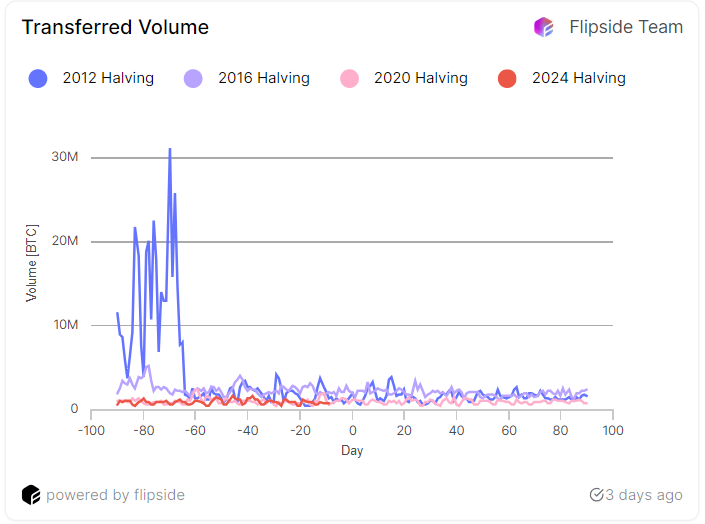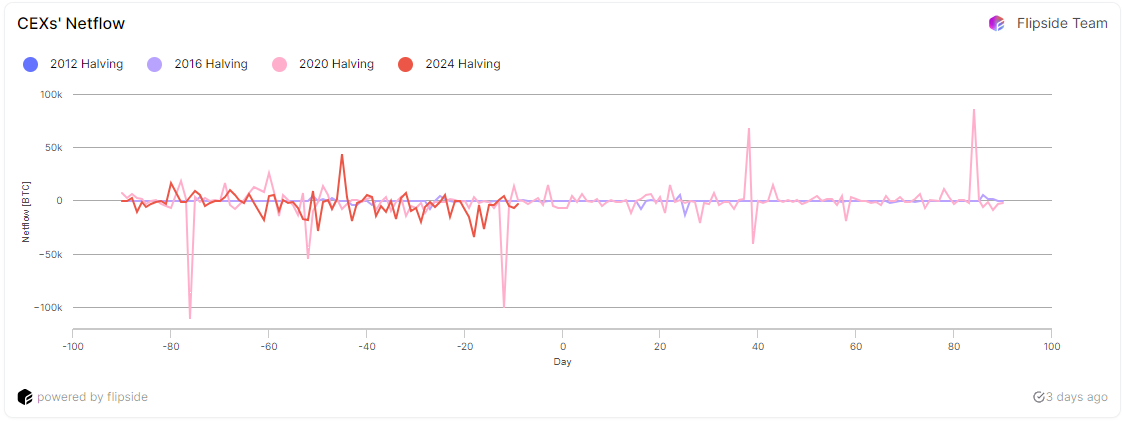We’re just days away from the next Bitcoin halving, and on-chain activity leading up to the event points to a cycle unlike any other.
As public trust in Bitcoin surges, we’re seeing transaction volumes surpass previous cycles and more gradual but consistent price growth. This combination of record-high transactions and relative price stability suggests a milder halving event followed by a more sustained growth cycle in the coming months.
Record-high transactions
The industry has experienced a sustained increase in BTC transactions leading up to every consecutive halving, with 2024 seeing the highest daily transaction volume and more extreme spikes in activity compared to previous run-ups. And while an increase in transaction volume is to be expected with every new cycle, this year’s activity appears to buck several trends.
Skyrocketing transaction volume
For instance, while daily transaction volume fluctuated similarly during the leadup to the 2016 and 2020 halvings, it skyrocketed this year. On average, the volatility of day-to-day transaction volume in the past three months is double that of the 2020 run-up, whereas the previous run-up only saw a moderate uptick relative to the 2016 cycle. At the same time, overall transaction volume has rarely dipped to levels seen in previous cycles as the market experiences a period of volatile, but elevated, activity.

Trend reversal in BTC transfers
Additionally, this year’s daily transferred volume is similar to that of the 2020 run-up in terms of BTC — but the actual dollar value of these transactions is multitudes higher given BTC’s price appreciation. This contrasts with the past trend, when BTC transfers dropped between 2016 and 2020. A growing daily transferred volume suggests growing user engagement and comfort with significant value transfers on the Bitcoin network as we approach this 2024 halving.
Sustained optimism and price support
On-chain activity from the past three months also shows more consistent price support for BTC this time around, relative to any other recent cycle.
Low price volatility and consistent growth
Leading up to the 2024 halving, BTC exhibited smaller price swings relative to every run-up since 2012, with a standard deviation of 2.2 (compared to 4.3 in 2020 and 2.9 in 2016).
This reduced price volatility — combined with the second-highest average BTC daily price increase of any halving run-up (0.56% daily growth vs. a 0.01% daily drop in the 2020 runup) — points toward a growing public confidence in the Bitcoin market. This holds true even when accounting for BTC’s recent price drop, and the fact that prices are twice as stable as the previous run-up and more consistently positive bodes well for the industry.

Record whale wallet inflows
Bitcoin’s outlook looks even more optimistic when considering that net flows reached a record-breaking 2.3 million BTC over the past three months among wallets that hold at least 1 BTC — a 45% increase over the previous cycle. While BTC whale inflows dropped 15% between the 2016 and 2020 cycles, 2024 has not witnessed any major sell-off events. Instead, 2024 is setting multiple new records in single-day BTC whale inflows, which is a strong indication of Bitcoin’s continued deep-pocketed support.
Increasing user sophistication
Unlike the frenzied new user activity that propelled the previous cycle, we are seeing signs that this year’s pre-halving activity has a higher rate of participation among more experienced existing BTC holders.
Heightened activity among existing users
As expected, the number of active daily addresses has increased relative to 2020, though not as significantly as the jump between 2016-2020. However, the number of new BTC addresses created leading up to the halving is lower than in 2020, which suggests that current market activity is largely driven by existing participants rather than new entrants.
Read more from our opinion section: This Bitcoin halving will be different — the institutions are here
The argument that existing BTC holders are deepening their engagement seems especially true given the trend-defying surge in transaction volume in recent months, relative to the number of BTC addresses created this year.
More balanced exchange net flows
It’s also worth noting that net BTC outflows from centralized exchanges (CEXs) are down 13% compared to the 2020 run-up, although this run-up is still seeing significant net outflows of BTC from exchanges. Net outflows are often interpreted as a bullish signal, as more BTC is transferred to private wallets and sell pressure drops as the supply of tradable BTC decreases.

And while 2024 also logged the highest single-day inflow of BTC of any halving run-up, this may simply indicate more nuanced market behavior as market participants split between holding and trading.
All of which is to say, the fact that net BTC flows to and from exchanges have not skewed excessively one way or another, relative to past cycles, indicates a more balanced, moderate investor sentiment as we approach the next halving.
Slow and steady wins the race
A significant cohort of the crypto community expected a massive pre-halving dump leading up to this year’s halving, but these fears appear to be overblown. While BTC’s value has trended down in recent days, this is still the first cycle to see a new all-time-high in BTC’s value pre-halving, and the 2024 run-up still appears to exhibit the most consistently positive growth of any recent cycle.
From this perspective, the fact that BTC’s value has not experienced any massive upwards swings recently may be taken as a positive sign. Rather than undergoing seismic price shifts and frenzied sentiments, we may be witnessing the beginning of a new phase in Bitcoin’s history — one characterized by gradual but consistent growth, sustained market confidence and more balanced user behavior.
In contrast to the dramatic ebbs and flows of some other crypto sectors, this even-keeled growth may be exactly what the industry needs.
 blockworks.co
blockworks.co